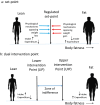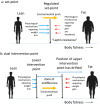Obesity: an evolutionary context
- PMID: 36394061
- PMCID: PMC9642988
- DOI: 10.1093/lifemeta/loac002
Obesity: an evolutionary context
Abstract
People completely lacking body fat (lipodystrophy/lipoatrophy) and those with severe obesity both show profound metabolic and other health issues. Regulating levels of body fat somewhere between these limits would, therefore, appear to be adaptive. Two different models might be contemplated. More traditional is a set point (SP) where the levels are regulated around a fixed level. Alternatively, dual-intervention point (DIP) is a system that tolerates fairly wide variation but is activated when critically high or low levels are breached. The DIP system seems to fit our experience much better than an SP, and models suggest that it is more likely to have evolved. A DIP system may have evolved because of two contrasting selection pressures. At the lower end, we may have been selected to avoid low levels of fat as a buffer against starvation, to avoid disease-induced anorexia, and to support reproduction. At the upper end, we may have been selected to avoid excess storage because of the elevated risks of predation. This upper limit of control seems to have malfunctioned because some of us deposit large fat stores, with important negative health effects. Why has evolution not protected us against this problem? One possibility is that the protective system slowly fell apart due to random mutations after we dramatically reduced the risk of being predated during our evolutionary history. By chance, it fell apart more in some people than others, and these people are now unable to effectively manage their weight in the face of the modern food glut. To understand the evolutionary context of obesity, it is important to separate the adaptive reason for storing some fat (i.e. the lower intervention point), from the nonadaptive reason for storing lots of fat (a broken upper intervention point). The DIP model has several consequences, showing how we understand the obesity problem and what happens when we attempt to treat it.
Keywords: BMI; adaptive; adiposity; body fat; dual-intervention point model; evolution; leptin resistance; metabolic programming; obesity; selection; set-point model.
© The Author(s) 2022. Published by Oxford University Press on behalf of Higher Education Press.
Conflict of interest statement
Jonh R Speakman holds the position of Editor-in-Chief of Life Metabolism, and is blinded from reviewing or making decisions for the manuscript.
Figures



References
-
- Lawrence R. Lipodystrophy and hepatomegaly with diabetes, lipaemia, and other metabolic disturbances: a case throwing new light on the action of insulin. Lancet 1946;247:724–31. - PubMed
-
- Garg A. Lipodystrophies. Am J Med 2000;108:143–52. - PubMed
-
- Chan JM, Rimm EB, Colditz GAet al. . Obesity, fat distribution, and weight gain as risk factors for clinical diabetes in men. Diabetes Care 1994;17:961–9. - PubMed
-
- Field AE, Coakley EH, Must Aet al. . Impact of overweight on the risk of developing common chronic diseases during a 10-year period. Arch Intern Med 2001;161:1581–6. - PubMed
Publication types
Grants and funding
LinkOut - more resources
Full Text Sources
